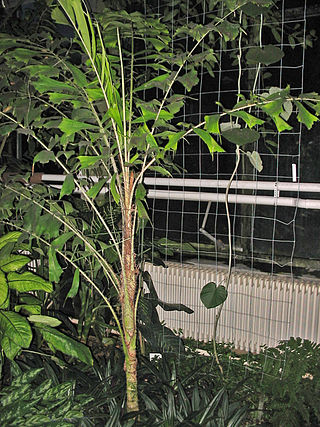
Aiphanes is a genus of spiny palms which is native to tropical regions of South and Central America and the Caribbean. There are about 26 species in the genus, ranging in size from understorey shrubs with subterranean stems to subcanopy trees as tall as 20 metres (66 ft). Most have pinnately compound leaves ; one species has entire leaves. Stems, leaves and sometimes even the fruit are covered with spines. Plants flower repeatedly over the course of their lifespan and have separate male and female flowers, although these are borne together on the same inflorescence. Although records of pollinators are limited, most species appear to be pollinated by insects. The fruit are eaten by several birds and mammals, including at least two species of amazon parrots.

Aparisthmium is a plant genus of the family Euphorbiaceae first described as a genus in 1840. It contains only one known species, Aparisthmium cordatum, native to South America and Costa Rica.
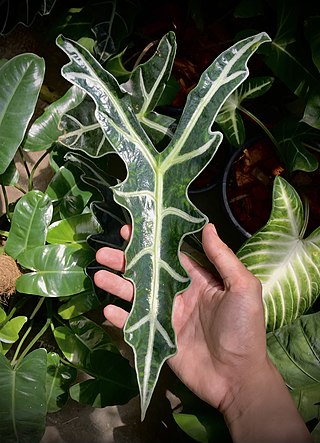
Alocasia sanderiana, commonly known as the kris plant or Sander's alocasia, is a plant in the family Araceae. It is endemic to Northern Mindanao in the Philippines, but is commonly grown as an ornamental plant worldwide. It is classified as critically endangered in the wild by the International Union for Conservation of Nature.

Selenicereus costaricensis, synonym Hylocereus costaricensis, known as the Costa Rican pitahaya or Costa Rica nightblooming cactus, is a cactus species native to Central America and north-eastern South America. The species is grown commercially for its fruit, called pitaya or pitahaya, but is also an impressive ornamental vine with huge flowers. The species may not be distinct from Selenicereus monacanthus.

Astrocaryum alatum is a species of palm with edible nuts, a flowering plant in the family Arecaceae. It is a common species found many types of rainforests and swamps in Honduras, Costa Rica, Nicaragua and Panama.

Normanbya is a monotypic genus of palms containing the single species Normanbya normanbyi, which is known by the common name black palm It is endemic to Queensland, Australia and is threatened by habitat destruction.
Glionnetia is a monotypic genus of flowering plants in the family Rubiaceae. The genus contains only one species, viz. Glionnetia sericea, which is endemic to Mahé and Silhouette Island in the Seychelles. The species thrives mainly on high ridges in the mountains and it does not seem to grow well at lower altitudes. Glionnetia sericea is a small flower with paniculate terminal inflorescences and it has capsules that are dispersed by wind.

Palicourea is a genus of flowering plants in the family Rubiaceae. It contains 694 species, which range from shrubs to small trees, and is distributed throughout the New World tropics.
Pentagonia rubriflora is a species of plant in the family Rubiaceae. It is endemic to Peru.

Burchellia is a monotypic genus of flowering plants in the family Rubiaceae. The genus contains only one species, viz. Burchellia bubalina, which is endemic to southern Africa: the Cape Provinces, KwaZulu-Natal and the Northern Provinces in South Africa, and Eswatini. It is commonly known as wild pomegranate (English) or wildegranaat (Afrikaans).

Atractocarpus chartaceus, commonly known as the narrow-leaved gardenia, is a species of evergreen flowering plant in the coffee family Rubiaceae. It is found in subtropical rainforest of eastern Queensland, Australia, and it is cultivated for its fragrant flowers and colourful fruit.

Dillenia alata, commonly known as red beech, golden guinea flower or golden guinea tree, is a tree in the Dilleniaceae family, found in tropical forests of the Moluccas, New Guinea, and northern Australia.

Protea magnifica, commonly known as the queen protea, is a shrub, which belongs to the genus Protea within the family Proteaceae, and which is native to South Africa.

Hypericum aciferum is a species of flowering plant in the St John's wort family Hypericaceae. It is a small shrub endemic to the Greek island of Crete. H. aciferum grows in a mat on the ground and has twisting branches, needle-like leaves, and long golden petals. Its flowers are also heterostylous, which means that the species can exhibit one of two flower types on different plants. This trait is unique within the genus Hypericum to H. aciferum, H. russeggeri, and H. aegypticum, the three species in section Adenotrias.
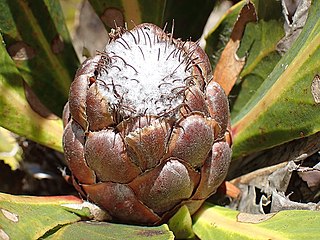
Protea vogtsiae, also known as the Kouga sugarbush, is a small flowering shrub of the genus Protea within the family Proteaceae, which is only found growing in the wild in the southern Cape Region of South Africa.

Protea rubropilosa, also known as the Transvaal sugarbush, escarpment sugarbush or Transvaal mountain sugarbush, is a flowering tree, that belongs to the genus Protea in the family Proteaceae. The plant only occurs in South Africa.

Protea convexa, also known as large-leaf sugarbush, is a rare flowering shrub in the genus Protea of the family Proteaceae, which is endemic to the southwestern Cape Region of South Africa.
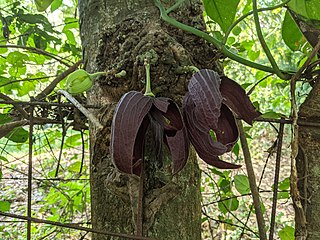
Sapranthus palanga, commonly known as palanca, is a species of cauliflorous tree in the family Annonaceae, native to the tropical regions of Central America, especially Costa Rica.
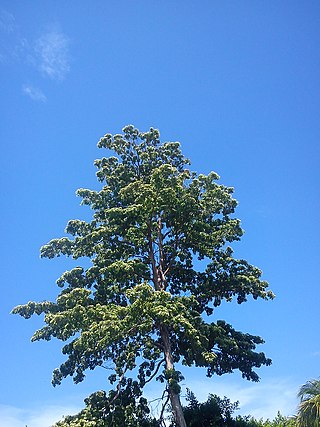
Calycophyllum candidissimum, the degami, dagame, or lemonwood, is a species of flowering plant in the family Rubiaceae, native to southern Mexico, Cuba, Central America, Colombia, and Venezuela. It is the national tree of Nicaragua. It is found in the ecoregion of Central American dry forests.
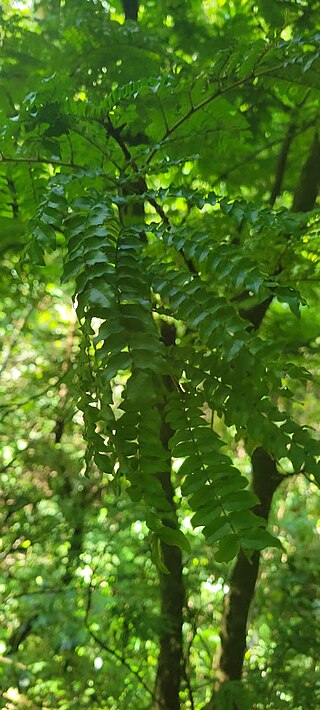
Cojoba costaricensis is a species in the Cojoba genus in the family Fabaceae. The native range of this species is Nicaragua to Panama. It is a tree and grows primarily in the wet tropical biome. Occurs commonly in mature forest at 1400-1600m in Costa Rica, especially in Monteverde. 5-15m tall subcanopy tree, with doubly compound fern-like leaves. There are tiny extrafloral nectar glands between each pair of leaflets. Cojoba costaricensis does not close its leaves at night in nyctinistic movement like other legumes.




















